seats Lexus IS250 2007 Operating the lights and windshield wipers / LEXUS 2007 IS350/250 OWNER'S MANUAL (OM53578U)
[x] Cancel search | Manufacturer: LEXUS, Model Year: 2007, Model line: IS250, Model: Lexus IS250 2007Pages: 445, PDF Size: 9.85 MB
Page 2 of 445

TABLE OF CONTENTSIndex
ii
1-1. Key information .............................. 2
Keys ......................................................... 2
1-2. Opening, closing and locking
the doors and trunk ..................... 4
Smart access system with
push-button start ............................. 4
Wireless remote control ............... 16
Doors..................................................... 19
Trunk..................................................... 23
1-3. Adjustable components ............ 26
Front seats .......................................... 26
Driving position memory ............. 28
Seat position memory .................... 31
Head restraints................................. 33
Seat belts ............................................ 34
Steering wheel
(manually adjustable type) ....... 40
Steering wheel
(power-adjustable type)............. 41
Anti-glare inside rear view
mirror ................................................ 42
Outside rear view mirrors ........... 43
1-4. Opening and closing the
windows and moon roof .......... 45
Power windows................................ 45
Moon roof ......................................... 481-5. Refueling ......................................... 51
Opening the fuel tank cap............ 51
1-6. Anti-theft system ......................... 54
Engine immobilizer system ......... 54
Alarm.................................................... 56
Theft prevention labels
(U.S.A.) ............................................ 58
1-7. Safety information ....................... 59
Correct driving posture ............... 59
SRS airbags ........................................ 61
Front passenger occupant
classification system .................... 72
Child restraint systems ................. 77
Installing child restraints .............. 80
2-1. Driving procedures..................... 90
Driving the vehicle .......................... 90
Starting the engine ......................... 98
Automatic Transmission ............. 101
Manual Transmission................... 105
Turn signal lever............................. 107
Parking brake ................................. 108
2-2. Instrument cluster ..................... 109
Gauges and meters ..................... 109
Indicators and warning
lights................................................... 115
1Before driving
2When driving
Page 8 of 445
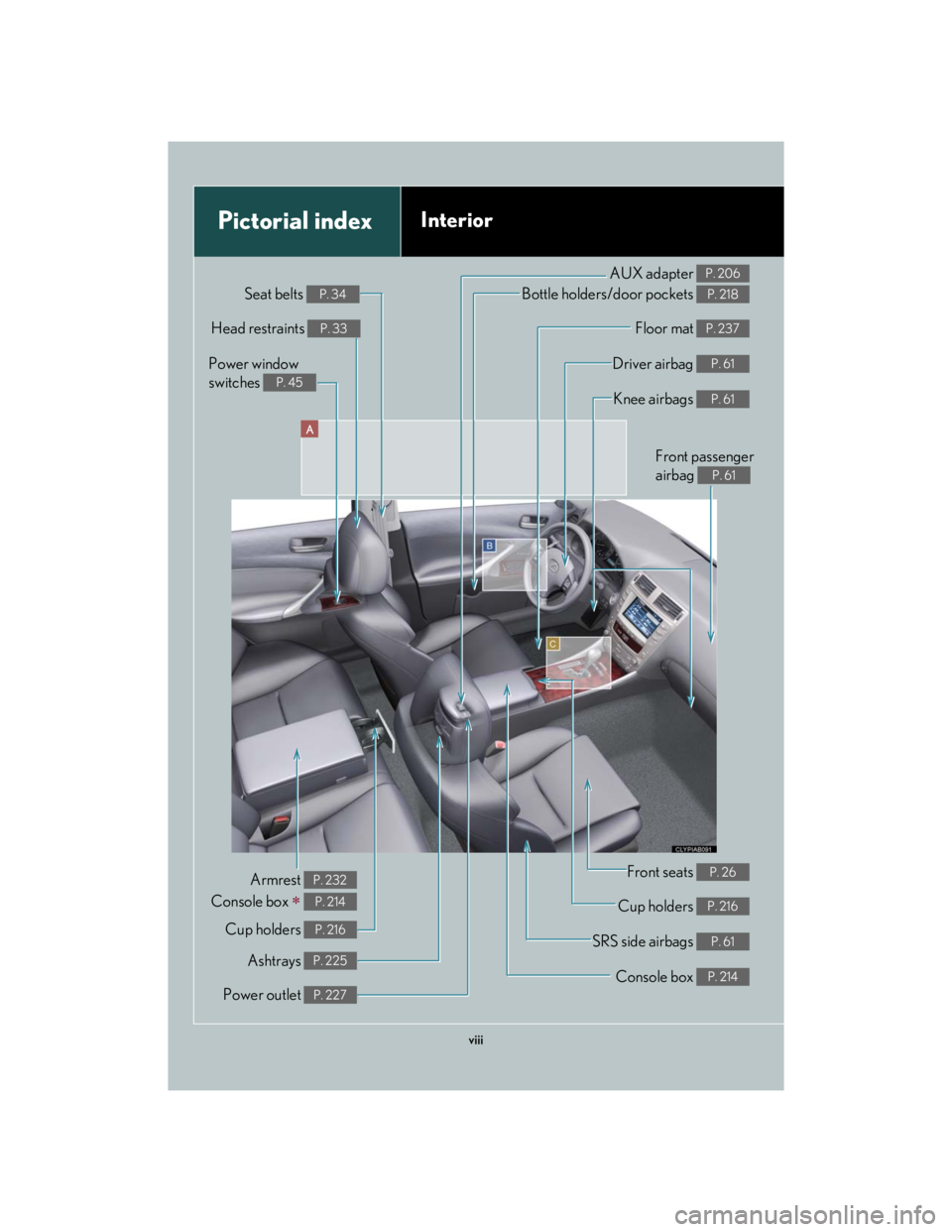
viii
A
Power window
switches
P. 45
Pictorial indexInterior
Seat belts P. 34
Front passenger
airbag
P. 61
Knee airbags P. 61
Driver airbag P. 61
Floor mat P. 237
Bottle holders/door pockets P. 218
Head restraints P. 33
Front seats P. 26
Cup holders P. 216
SRS side airbags P. 61
Console box P. 214
Power outlet P. 227
Ashtrays P. 225
Cup holders P. 216
Armrest
Console box
P. 232
P. 214
AUX adapter P. 206
Page 19 of 445

Before driving1
1
1-1. Key information ............................ 2
Keys....................................................... 2
1-2. Opening, closing and locking
the doors and trunk................... 4
Smart access system with
push-button start .......................... 4
Wireless remote control............. 16
Doors.................................................. 19
Trunk .................................................. 23
1-3. Adjustable components .......... 26
Front seats ....................................... 26
Driving position memory .......... 28
Seat position memory ................. 31
Head restraints.............................. 33
Seat belts ......................................... 34
Steering wheel
(manually adjustable type) .... 40
Steering wheel
(power-adjustable type) .......... 41
Anti-glare inside rear view
mirror ............................................. 42
Outside rear view mirrors ........ 431-4. Opening and closing the
windows and moon roof ....... 45
Power windows ............................. 45
Moon roof ....................................... 48
1-5. Refueling ...................................... 51
Opening the fuel tank cap ......... 51
1-6. Anti-theft system ...................... 54
Engine immobilizer system ...... 54
Alarm ................................................ 56
Theft prevention labels
(U.S.A.) .......................................... 58
1-7. Safety information .................... 59
Correct driving posture ............ 59
SRS airbags ...................................... 61
Front passenger occupant
classification system.................. 72
Child restraint systems ............... 77
Installing child restraints ............ 80
Page 44 of 445
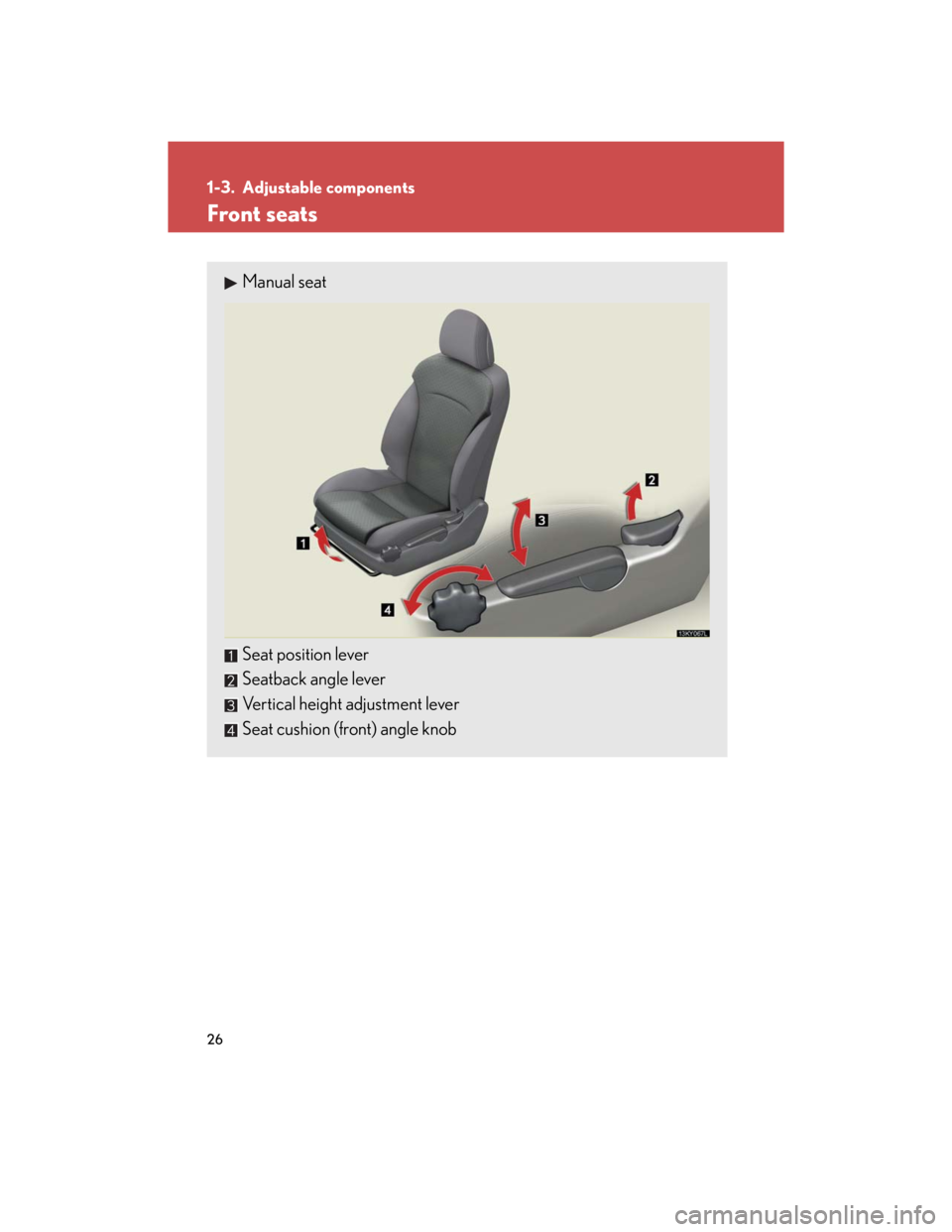
26
1-3. Adjustable components
Front seats
Manual seat
Seat position lever
Seatback angle lever
Vertical height adjustment lever
Seat cushion (front) angle knob
Page 51 of 445
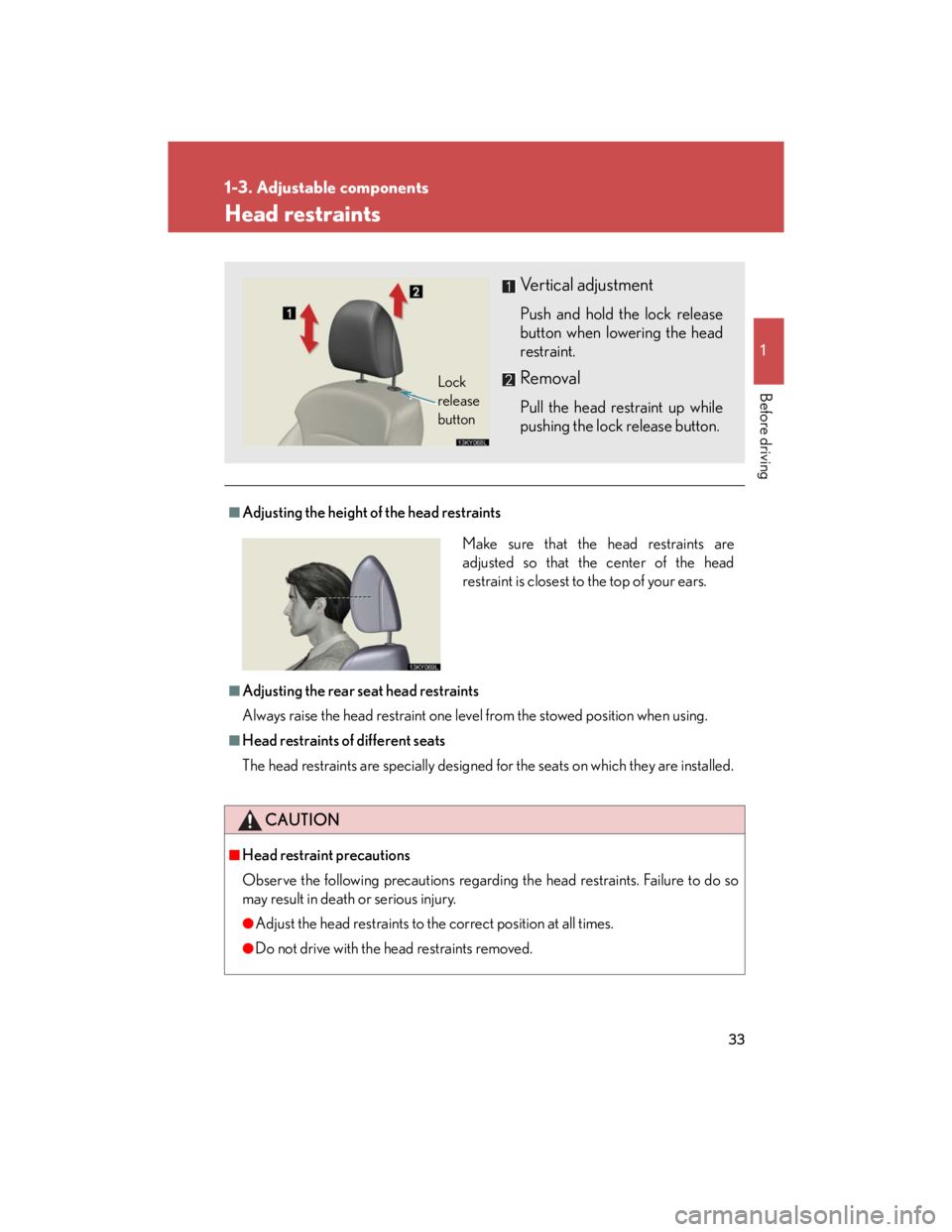
33
1
1-3. Adjustable components
Before driving
Head restraints
■Adjusting the height of the head restraints
■Adjusting the rear seat head restraints
Always raise the head restraint one level from the stowed position when using.
■Head restraints of different seats
The head restraints are specially designed for the seats on which they are installed.
CAUTION
■Head restraint precautions
Observe the following precautions regarding the head restraints. Failure to do so
may result in death or serious injury.
●Adjust the head restraints to the correct position at all times.
●Do not drive with the head restraints removed.
Vertical adjustment
Push and hold the lock release
button when lowering the head
restraint.
Removal
Pull the head restraint up while
pushing the lock release button.
Lock
release
button
Make sure that the head restraints are
adjusted so that the center of the head
restraint is closest to the top of your ears.
Page 53 of 445
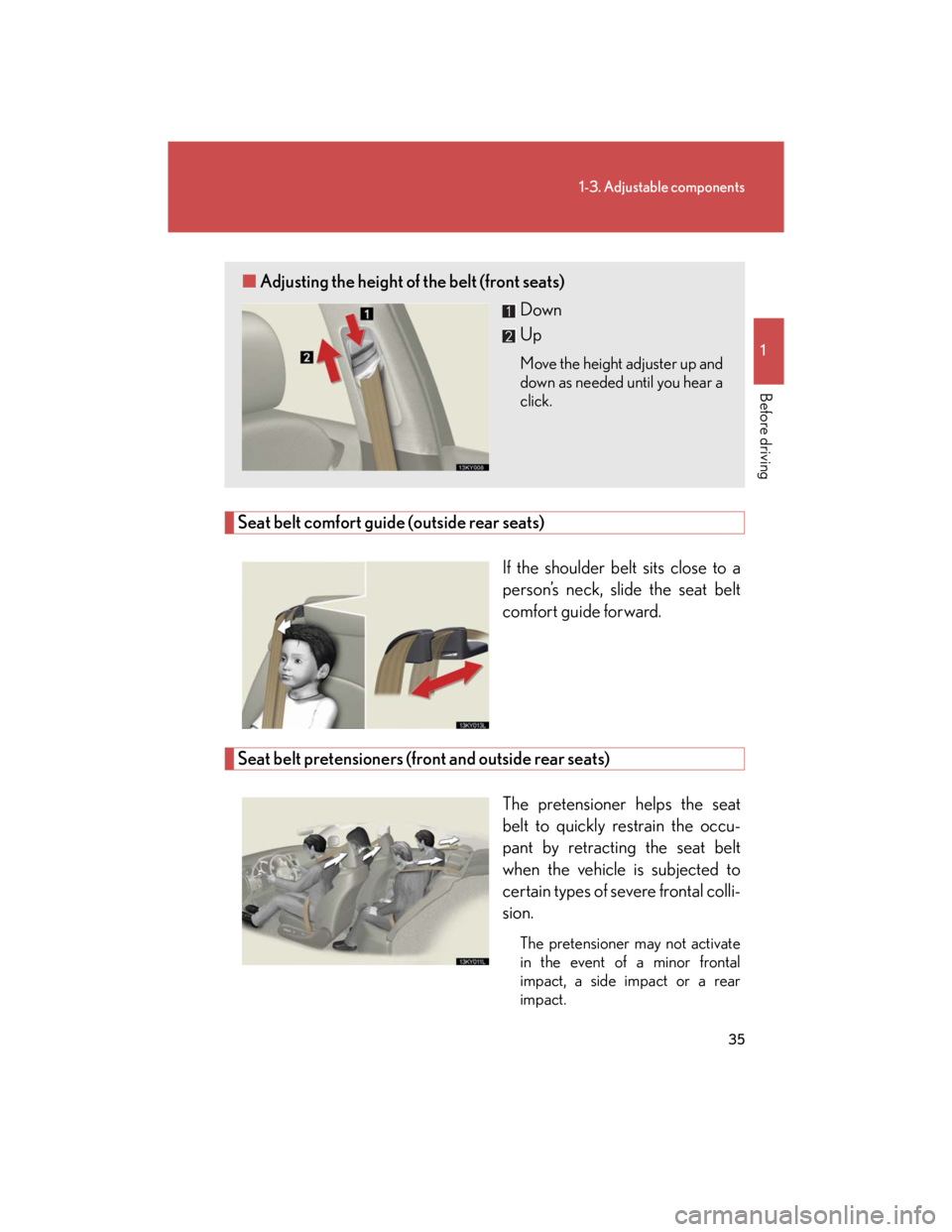
35
1-3. Adjustable components
1
Before driving
Seat belt comfort guide (outside rear seats)
If the shoulder belt sits close to a
person’s neck, slide the seat belt
comfort guide forward.
Seat belt pretensioners (front and outside rear seats)
The pretensioner helps the seat
belt to quickly restrain the occu-
pant by retracting the seat belt
when the vehicle is subjected to
certain types of severe frontal colli-
sion.
The pretensioner may not activate
in the event of a minor frontal
impact, a side impact or a rear
impact.
■Adjusting the height of the belt (front seats)
Down
Up
Move the height adjuster up and
down as needed until you hear a
click.
Page 54 of 445

36
1-3. Adjustable components
Pre-collision seat belts (front seats of vehicles with pre-collision system)
When the pre-collision sensor detects an obstacle and determines that a
collision is unavoidable, the seat belts lessen collision injury by retracting
the slack in the front seat belts before the collision, thus restraining the
driver and passenger at an earlier stage.
The seat belts will also operate in the event of sudden braking. (P. 1 5 4 )
■Emergency locking retractor (ELR)
The retractor will lock the belt during a sudden stop or on impact. It may also lock if
you lean forward too quickly. A slow, easy motion will allow the belt to extend so that
you can move around fully.
■Automatic locking retractor (ALR)
When a passenger's shoulder belt is completely extended and then retracted even
slightly, the belt is locked in that position and cannot be extended. This feature is
used to hold the CRS firmly. To free the belt again, fully retract the belt and then pull
the belt out once more. (P. 8 0 )
■Pregnant women
Obtain medical advice and wear the seat belt
in the proper way. (P. 3 4 )
Women who are pregnant should position
the lap belt as low as possible over the hips in
the same manner as other occupants. Extend
the shoulder belt completely over the shoul-
der and position the belt across the chest.
Avoid belt contact over the rounding of the
abdominal area.
If the seat belt is not worn properly, not only a
pregnant woman, but also the fetus could suf-
fer death or serious injury as a result of sud-
den braking or a collision.
Page 56 of 445

38
1-3. Adjustable components
CAUTION
■Wearing a seat belt
Observe the following precautions to reduce the risk of injury in the event of sud-
den braking or an accident.
Failing to do so may cause death or severe injury.
●Ensure that all passengers wear a seat belt.
●Always wear a seat belt properly.
●Each seat belt should be used by one person only. Do not use a seat belt for more
than one person at once, including children.
●Lexus recommends that children be seated in the rear seat and always use a seat
belt and/or an appropriate child restraint system.
●Do not recline the seat any more than necessary to achieve a proper seating
position. The seat belt is most effective when the occupants are sitting up straight
and well back in the seats.
●Do not wear the shoulder belt under your arm.
●Always wear your seat belt low and snug across your hips.
■Seat belt damage and wear
●Do not damage the seat belts by allowing the belt, plate, or buckle to be jammed
in the door.
●Inspect the seat belt system periodically. Check for cuts, fraying, and loose parts.
Do not use a damaged seat belt until it is replaced. Damaged seat belts cannot
protect an occupant from death or serious injury.
●Ensure that the belt and tab are locked and the belt is not twisted.
If the seat belt does not function correctly, immediately contact your Lexus
dealer.
●Replace the seat assembly, including the belts, if your vehicle has been involved in
a serious accident, even if there's no obvious damage.
●Do not attempt to install, remove, modify, disassemble or dispose of the seat belts.
Have any necessary repairs carried out by your Lexus dealer. Inappropriate han-
dling of the pretensioner may prevent it from operating properly resulting in
death or serious injury.
Page 78 of 445
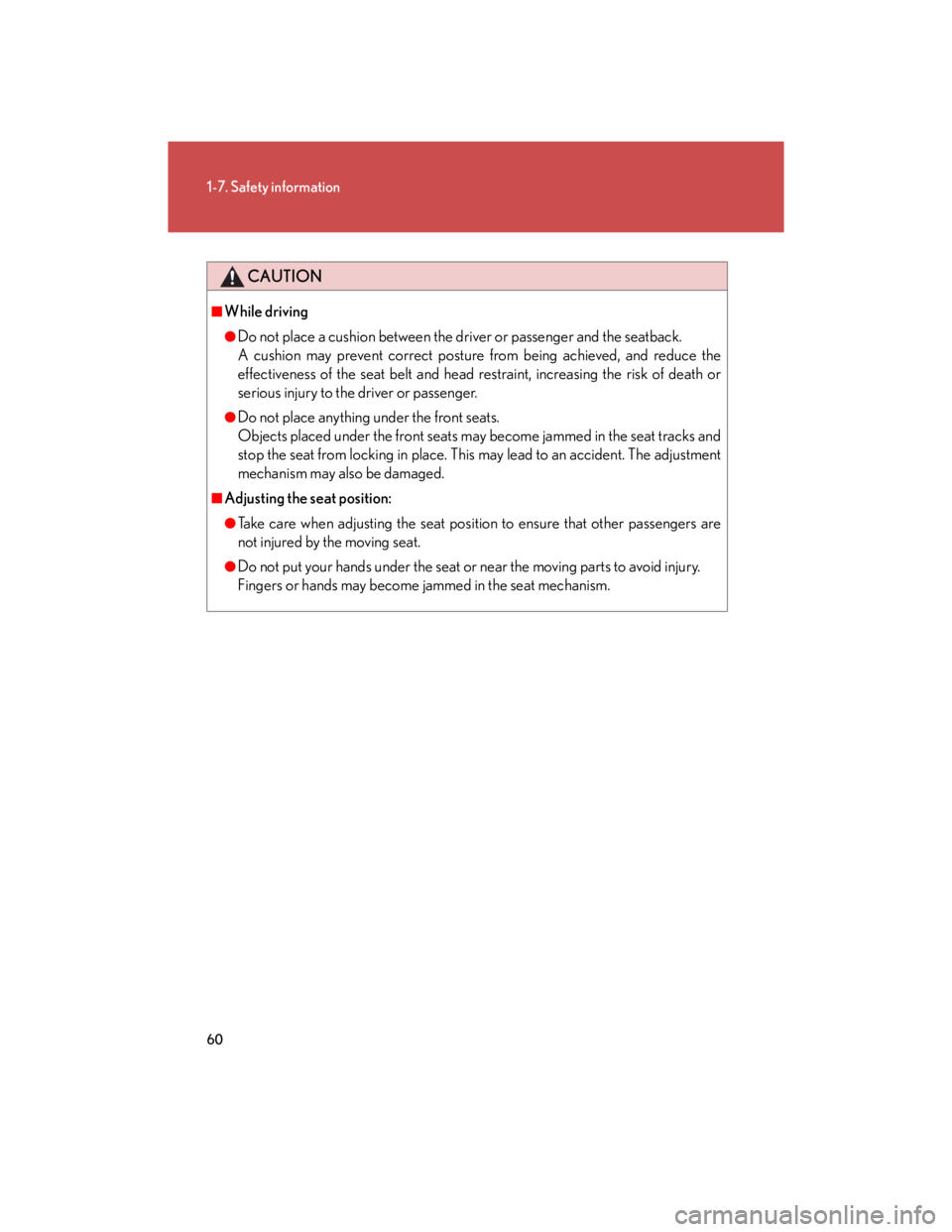
60
1-7. Safety information
CAUTION
■While driving
●Do not place a cushion between the driver or passenger and the seatback.
A cushion may prevent correct posture from being achieved, and reduce the
effectiveness of the seat belt and head restraint, increasing the risk of death or
serious injury to the driver or passenger.
●Do not place anything under the front seats.
Objects placed under the front seats may become jammed in the seat tracks and
stop the seat from locking in place. This may lead to an accident. The adjustment
mechanism may also be damaged.
■Adjusting the seat position:
●Take care when adjusting the seat position to ensure that other passengers are
not injured by the moving seat.
●Do not put your hands under the seat or near the moving parts to avoid injury.
Fingers or hands may become jammed in the seat mechanism.
Page 81 of 445

63
1-7. Safety information
1
Before driving
In certain types of severe frontal or side impacts, the SRS airbag system
triggers the airbag inflators. A chemical reaction in the inflators quickly
fills the airbags with non-toxic gas to help restrain the motion of the occu-
pants.
■SRS warning light
This warning light system monitors the airbag sensor assembly, front airbag sensors,
side and curtain shield airbag sensor assemblies, curtain shield airbag sensor
assemblies, driver's seat position sensor, driver's seat belt buckle switch, seat belt
pretensioner assemblies, inflators, interconnecting wiring and power sources.
(P. 3 4 0 )
■If the SRS airbags deploy (inflate)
●Bruising and slight abrasions may result from contact with a deploying (inflating)
SRS airbag.
●A loud noise and white powder will be emitted.
●Parts of the airbag module (steering wheel hub, airbag cover and inflator) as
well as the front seats, and parts of the front pillar, rear pillar and roof side rail,
may be hot for several minutes. The airbag itself may also be hot.
●The front windshield may crack.
■Operating conditions (front airbags)
●The SRS front airbags will deploy if the severity of the frontal impact is above the
designed threshold level, comparable to an approximate 15 mph (25 km/h) col-
lision when the vehicle impacts straight into a fixed barrier that does not move
or deform.
However, this threshold velocity will be considerably higher if the vehicle strikes
an object, such as a parked vehicle or sign pole, which can move or deform on
impact, or if the vehicle is involved in an underride collision (e.g. a collision in
which the front of the vehicle "underrides", or goes under, the bed of a truck, etc.).
●It is possible that in some collisions where the forward deceleration of the vehi-
cle is very close to the designed threshold level, the SRS front airbags and the
seat belt pretensioners may not activate together.
●The SRS front passenger airbag will not activate if there is no passenger sitting
in the front passenger seat. However, the front passenger airbag may deploy if
luggage is put in the seat, or the seat belt is fastened, even if the seat is unoccu-
pied. (P. 7 2 )